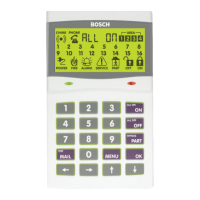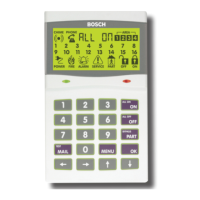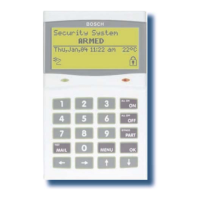5
Bosch Security Systems 09/06 BLCC100R
Solution 16
plus
Quick Start Guide
About The Panel
Mo unt ing The Cabi net
The cabinet should be mounted via 4 (screws/bolts)
through the 4 mounting holes in the base. Ensure that
the enclosure is mounted on a solid, flat, vertical surface
such that the base will not flex when tightened. Cabinet
dimensions are shown below.
Figure 1 : Cabinet Dimensions
Mo dule Spaces
Each cabinet has 4 identical module spaces and 1 large
module space that is allocated for non Solution PCB boards
(eg. a securitel STU).
Each space includes 4 x 10mm stand-offs that the optional
expander PCB boards will mount using screws (screws will
be supplied with each board). The expander board will be
earthed via the screws that mount the PCB to the metal
box.
All modules will mount on these module spaces.
A list of the PCB boards is detailed below
Module Space Occupied
Solution 16
plus
Control Panel 2 Module Spaces
CM104 Zone Expander 1 Module Space
CM110 Output Expander 1 Module Space
CM120 LAN Power Supply 1 Module Space
CM195 RF Receiver Expander 1 Module Space
Using the above table, the installer can determine how
many modules can be mounted in a single cabinet box. On
some export models, module 3 will not be available as the
transformer mounts in this location.
Figure 2: Metal Box – Module Space Allocations
Pa nel Led Indic ato rs
The Solution 16
plus
PCB has two LED indicators (Dialler and
Status LED’s) which display the following information.
Condition
Meaning
Off Offline
On On Line (Dialling/Answered)
Flashing Incoming Call
Table 1: Dialler LED Meanings
Condition
Meaning
Off Error
On Error
Flash Once Every 2 Seconds
OK
Flash Fast AC or Battery Trouble
Table 2: Status LED Meanings
During factory defaulting the Status and Dialler
LED indicators will be on steady for approximately
15 seconds.
Pa nel Ad dre ss Sele ct
The Solution 16
plus
pcb has three DIP switches (called Panel
Node Select) that must be set. In a multi-panel system, each
control panel (Node) must to be set to a unique address.
Panel NODE Select DIP Switch Address Settings
Panel to Address S1 S2 S3
Panel 1 Off Off Off
Panel 2
On Off Off
Panel 3 Off On Off
Panel 4 On On Off
Panel 5 Off Off
On
Panel 6
On Off On
Panel 7 Off On On
Panel 8
On On On
Table 3: Panel Node Select

